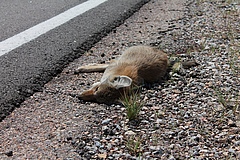More and more roads but little knowledge about their impact on wildlife

Research on traffic accidents currently focuses mainly on carnivore mammals, ungulates, marsupials and turtles. (Picture: Pixabay)

Only seven percent of the studies that list roadkills as a cause of death also examine the effects on population development. (Picture: Pixabay)
Traffic probably poses one of the greatest risks to animal populations. However, we currently know very little about this issue.
Based on a media release by the Complutense University of Madrid (UCM)
Madrid/Leipzig/Halle. In regions with a very dense road network like, for example, Germany, vehicles are probably one of the main threats to all types of wildlife. However, the extent to which this factor affects populations cannot be determined due to a lack of data. This has now been presented by a team of scientists led by the Complutense University of Madrid (UCM), the German Centre for Integrative Biodiversity Research (iDiv) and the Martin Luther University Halle-Wittenberg (MLU) in the journal Perspectives in Ecology and Conservation. The analysis of relevant literature revealed that studies are too limited, involving only a few regions and species. By systematically recording roadkills, the scientists see great potential for assessing the risk of extinction to animal species.
In their meta-study, the Spanish scientists reviewed over a thousand studies on the effects of road networks on wildlife. They found that the existing data is limited to high-income countries and only a few species groups, while particularly species-rich regions such as Southeast Asia, South America and Central Africa are hardly covered at all. Also, the species spectrum is only fragmentarily represented here. 90 percent of the data cover large mammals, mainly bears, deer and antelopes, but also kangaroos, koalas and turtles. Only two percent of the species recorded were those considered threatened by traffic in the IUCN Red List.
The rapid expansion of road networks poses major challenges for wildlife: On the one hand, many animals die directly as a result of being struck by vehicles, and on the other hand, roads fragment the land. For many species, this creates impassable barriers that make successful reproduction difficult.
In order to be able to introduce protection measures, it is important to complete the hitherto incomplete picture. Unresearched species such as primates, bats and invertebrates, which are also known to be affected by road networks, must be given greater consideration in monitoring. The proportion of Red List species among those examined is still too low to understand the effect of road networks on threatened species. In addition, this infrastructure is developed to different extents in countries with different economic strengths. This makes it difficult to compare the studies internationally.
“In order to close the knowledge gaps, future research, instead of limiting itself only to the recording of wildlife-vehicle collisions, should examine how roadkill affects population dynamics,” suggests first author Dr Rafael Barrientos, postdoctoral researcher at UCM. “Moreover, more research needs to be done on whether lack of connectivity and mitigation measures, such as green bridges, affect population survival along roads.”
Last author Prof Dr Henrique Pereira, head of the research group “Biodiversity and Conservation” at iDiv and the MLU, also sees a strong need to catch up: “Until now the literature has been dominated by empirical studies looking at animal mortality hotspots on roads, but little attention has been given to systematically assessing how much roads contribute to high risk of species extinction. It is now time to go beyond those empirical studies and use population models to assess the impact of roads on the extinction risk of species so that mitigation measures can target the species most affected."
Original publication:
(Scientists with iDiv affiliation bold)
Barrientos, R., Ascensão, F., D'Amico, M., Grilo, C., & Pereira, H. M. (2021): The Lost Road: Do transportation networks imperil wildlife population persistence? Perspectives in Ecology and Conservation, DOI: 10.1016/j.pecon.2021.07.004.
Contact:
Dr Rafael Barrientos
Evolution and conservation biology
Universidad Complutense Madrid
Phone: +34 91 394 4689
Email: rbarrientos@ucm.es
Web: www.ucm.es/bcveng//rafael-barrientos
Prof Dr Henrique Miguel Pereira
Head of research group Biodiversity Conservation
German Centre for Integrative Biodiversity Research (iDiv) Halle-Jena-Leipzig
Martin Luther University Halle-Wittenberg (MLU)
Email: henrique.pereira@idiv.de
Sebastian Tilch
Media and Communications
German Centre for Integrative Biodiversity Research (iDiv) Halle-Jena-Leipzig
Phone: +49 341 97 33197
Email: sebastian.tilch@idiv.de
Web: www.idiv.de/media
